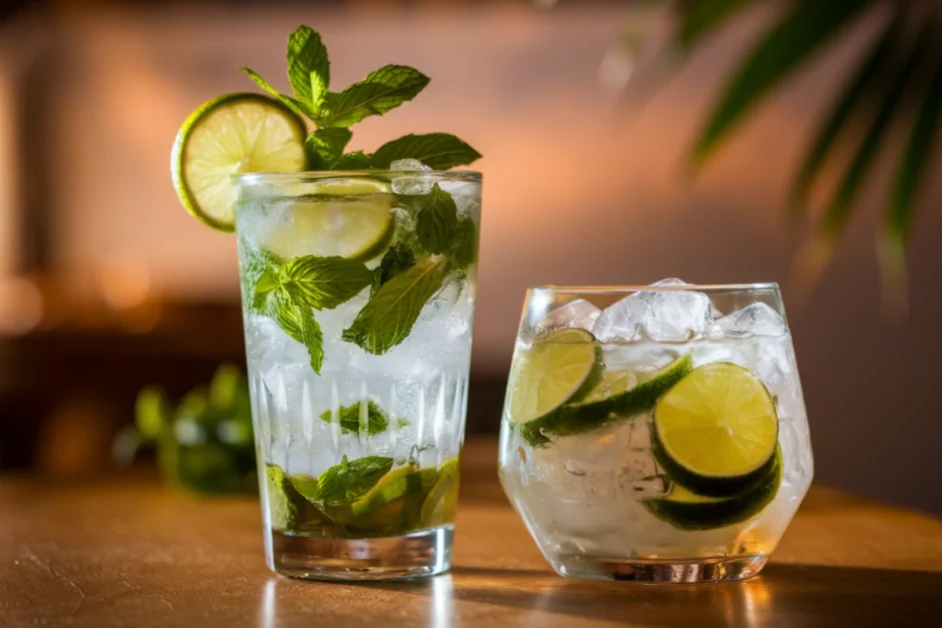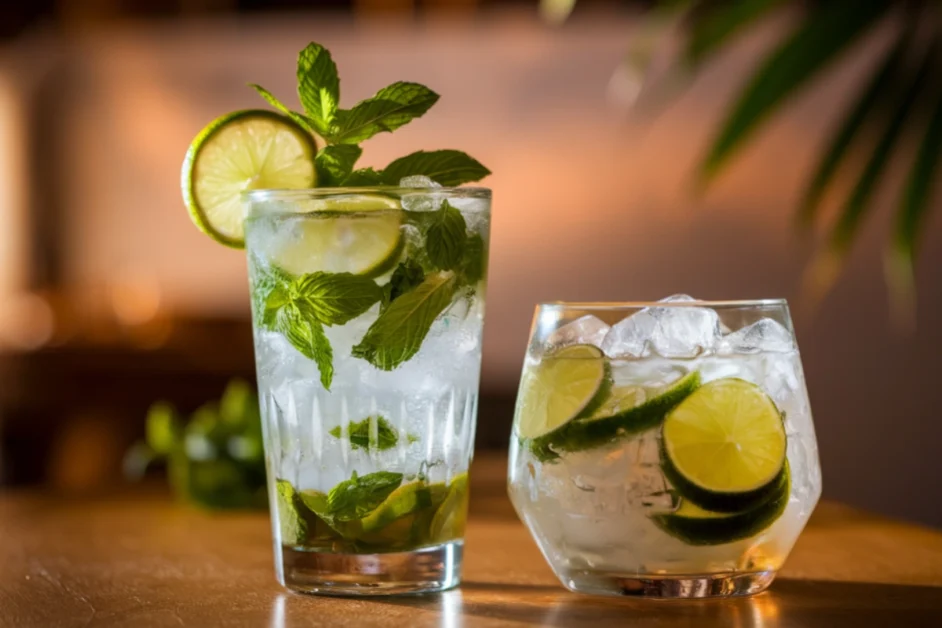When it comes to refreshing cocktails, the Mojito and Caipirinha stand out as favorites in many parts of the world. But what’s the difference between a Mojito and a Caipirinha? Both drinks are known for their vibrant flavors and simple ingredients, yet they offer distinct experiences. Let’s dive into what sets these two cocktails apart.
Introduction to Mojito and Caipirinha
The Mojito and Caipirinha are not just drinks; they are cultural icons in their respective countries. The Mojito hails from Cuba, bringing with it a mix of minty freshness and a hint of sweetness. On the other hand, the Caipirinha is Brazil’s national cocktail, known for its bold, earthy flavors thanks to cachaça. Understanding the differences between these two drinks begins with knowing their roots and ingredients.
Curious about how these two classics differ? To start, the Mojito uses white rum, while the Caipirinha relies on cachaça, a unique Brazilian spirit. Both spirits bring their distinct character to the drinks, influencing everything from flavor to texture. To explore more about the key distinctions, check out this Caipirinha vs Mojito guide.
Historical Background of Mojito and Caipirinha
The history of the Mojito is deeply rooted in Cuban culture. Originating in the 16th century, it was initially known as “El Draque,” named after the English sea captain Sir Francis Drake. Over time, the drink evolved, with mint becoming a staple ingredient that defined its refreshing taste.
In contrast, the Caipirinha has its origins in Brazil. It started as a medicinal drink, made with cachaça, lime, and sugar, aimed at treating common illnesses. Today, it is celebrated as Brazil’s national cocktail, enjoyed at social gatherings and festive occasions.
Key Ingredients in a Mojito
The Mojito is a straightforward cocktail with just a few ingredients:
- White Rum: The base spirit that gives the Mojito its smooth kick.
- Mint Leaves: Fresh mint adds a burst of refreshing flavor.
- Lime Juice: Offers a tangy counterbalance to the sweetness.
- Sugar: Adds a touch of sweetness, typically in the form of simple syrup or granulated sugar.
- Soda Water: Provides a light, fizzy finish.
These ingredients come together to create a cocktail that is both refreshing and light, perfect for hot days or a relaxing evening.
For those interested in exploring other classic drinks, you might enjoy learning about the gin martini recipe, another staple in the world of cocktails.
Key Ingredients in a Caipirinha
The Caipirinha is even more simplified but no less flavorful:
- Cachaça: A Brazilian spirit made from fermented sugarcane juice, it’s the star of the Caipirinha.
- Lime: Fresh lime wedges are muddled directly in the glass, releasing essential oils and juice.
- Sugar: Granulated sugar is traditionally used to balance the tartness of the lime.
- Ice: Crushed ice chills the drink, making it refreshing and potent.
The Caipirinha is all about bold, earthy flavors, with cachaça bringing a distinctive taste that sets it apart from other cocktails. If you’re interested in how these ingredients work together, Exploring the Differences Between Mojito and Caipirinha provides a detailed comparison.
Differences in Alcohol Base
One of the most significant differences between the Mojito and Caipirinha lies in the alcohol used. The Mojito uses white rum, a spirit made from sugarcane byproducts like molasses. White rum is typically light and smooth, contributing to the Mojito’s refreshing profile.
In contrast, the Caipirinha is made with cachaça, a spirit unique to Brazil. Unlike rum, cachaça is made directly from sugarcane juice, giving it a more robust and earthy flavor. This difference in the base alcohol results in distinct taste profiles for each cocktail, with the Caipirinha offering a more intense, slightly grassy flavor compared to the Mojito.
Preparation Techniques
The preparation of a Mojito and a Caipirinha also differs, influencing the final taste and texture. To make a Mojito, fresh mint leaves are gently muddled with sugar and lime juice to release their flavors without over-crushing them, which can make the drink bitter. White rum is then added, followed by soda water and ice. The drink is typically garnished with a sprig of mint.
On the other hand, the Caipirinha is simpler in its preparation. Lime wedges are muddled with sugar directly in the glass, ensuring the essential oils from the lime peel mix with the juice. Cachaça is then poured over the muddled mixture, followed by a generous amount of crushed ice. The result is a cocktail that’s both strong and refreshing, with the lime and cachaça taking center stage.
For a more in-depth look at how these drinks are made, you can visit Which Rum Cocktail is Best?, where Mojito and Caipirinha preparation techniques are explored in detail.
If you’re interested in exploring other drink recipes that offer a rich cultural experience, you might find the traditional Colombian shrimp cocktail recipe to be a delightful addition to your culinary adventures.
Flavor Profiles and Taste Differences

When it comes to flavor, the Mojito is known for its refreshing, light profile. The combination of mint and lime provides a crisp, clean taste, while the soda water adds a fizzy touch that makes the drink especially cooling.
The Caipirinha, by contrast, is bold and slightly more intense. The flavor of cachaça dominates, offering earthy and grassy notes that are balanced by the tartness of the lime and the sweetness of the sugar. Unlike the Mojito, the Caipirinha does not include soda water, making it a stronger, more concentrated drink.
Serving and Presentation Differences
Presentation plays a key role in how these cocktails are enjoyed. The Mojito is typically served in a tall glass with whole mint leaves and a lime wedge as garnish. The soda water gives the drink a slightly lighter appearance, with the mint leaves floating throughout.
The Caipirinha, on the other hand, is served in a short, sturdy glass, with lime wedges and crushed ice prominently visible. The lack of soda water gives the Caipirinha a more solid, compact look, reflecting its more intense flavor.
Global Popularity of Mojito vs. Caipirinha
Both the Mojito and Caipirinha have gained global recognition, but they appeal to slightly different audiences. The Mojito has become a staple in bars around the world, appreciated for its refreshing taste and easy-drinking nature. It’s particularly popular during the summer months and is often featured on cocktail menus in a variety of settings.
The Caipirinha, while also popular, has a more niche appeal, especially outside Brazil. It is often favored by those who enjoy bold, strong flavors and are looking for something a bit different from the usual rum-based cocktails. Despite its more robust taste, the Caipirinha has found a place on international cocktail menus, especially in establishments that celebrate Latin American culture.
For those who enjoy discovering new flavors, you might also be interested in the easy 3-ingredient sloppy joe recipe, a quick and delicious dish that complements a variety of cocktails.
Mojito and Caipirinha in Popular Culture
These two cocktails have made their mark in popular culture as well. The Mojito has been immortalized in songs, movies, and even literature, often associated with relaxation and tropical settings. Its widespread appeal has made it a symbol of laid-back leisure.
The Caipirinha, while perhaps less mainstream, is deeply embedded in Brazilian culture and has been featured in various international media that highlight Brazilian traditions and lifestyle. The drink is often associated with celebrations and gatherings, reflecting its role as a social lubricant in its home country.
Frequently Asked Questions
1. What is the main difference between a Mojito and a Caipirinha?
- The main difference lies in the alcohol used: Mojito is made with white rum, while Caipirinha uses cachaça. This results in different flavor profiles, with the Mojito being more refreshing and the Caipirinha offering a bolder taste.
2. Which is stronger: Mojito or Caipirinha?
- Generally, the Caipirinha is stronger due to the use of cachaça and the absence of soda water, which dilutes the alcohol in a Mojito.
3. Can you substitute rum for cachaça in a Caipirinha?
- While you can substitute rum for cachaça, the drink would no longer be a traditional Caipirinha. Instead, it would be more similar to a Caipiríssima.
4. Are there non-alcoholic versions of Mojito and Caipirinha?
- Yes, non-alcoholic versions exist. A Mojito can be made as a “virgin” by omitting the rum, and a similar approach can be taken with the Caipirinha by replacing cachaça with a non-alcoholic alternative.
5. Which drink is more popular globally?
- The Mojito is more globally recognized and commonly found on cocktail menus worldwide, while the Caipirinha is more popular within Brazil and among those who appreciate Brazilian culture.
Conclusion: Understanding the Differences
In summary, the Mojito and Caipirinha are both excellent choices for cocktail enthusiasts, each offering a unique experience. The Mojito is perfect for those who enjoy a refreshing, minty drink, while the Caipirinha caters to those who prefer bold, earthy flavors. Knowing the differences between these two iconic cocktails allows you to appreciate each one for what it brings to the table, whether you’re relaxing on a sunny day or celebrating with friends.
This article has covered the essential distinctions between the Mojito and Caipirinha, from their ingredients and preparation to their global impact. Whether you’re a fan of one or both, these cocktails represent the rich cultural heritage of their respective countries and continue to be enjoyed by people all around the world.
